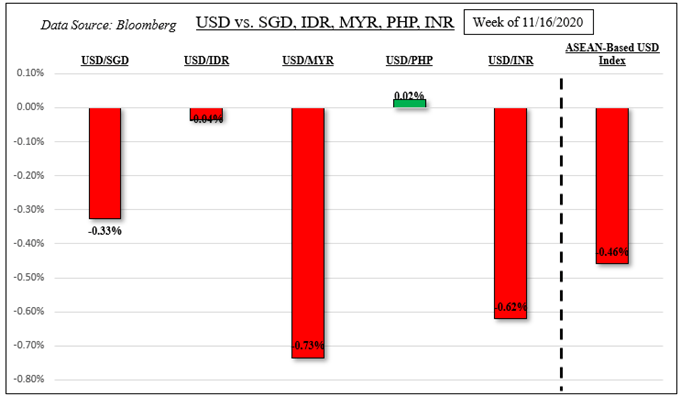US Dollar, Singapore Dollar, Indonesian Rupiah, Malaysian Ringgit, Philippine Peso – Talking Points
- US Dollar extended weakness against most ASEAN currencies
- Emerging markets brushing off US woes which remain key risk
- ASEAN data: Singapore GDP and CPI, Indian Q3 GDP Friday
US Dollar ASEAN Weekly Recap
The haven-linked US Dollar aimed broadly lower against ASEAN currencies such as the Malaysian Ringgit and Singapore Dollar this past week. Capital seemed to continue flowing into developing economies, with the MSCI Emerging Markets Index (EEM) registering a 1.51% 5-day gain. This is compared to weakness in US equities, with the exception of the tech-heavy Nasdaq Composite as the Dow Jones and S&P 500 declined.
A couple of notable exceptions were the Indonesian Rupiah and Philippine Peso, which were little changed – see chart below. This is likely due to the Indonesian and Philippine Central Banks unexpectedly cutting benchmark lending rates. Both of them cited concerns about near-term inflation prospects. Bank of Indonesia also reiterated its commitment to stabilizing IDR, it sees the Rupiah as fundamentally undervalued.


Recommended by Daniel Dubrovsky
How can you overcome common pitfalls in FX trading?
Last Week’s US Dollar Performance

*ASEAN-Based US Dollar Index averages USD/SGD, USD/IDR, USD/MYR and USD/PHP
External Event Risk – Covid Cases, Treasury-Fed Spat, Consumer Confidence
ASEAN currencies can be quite sensitive to capital flows, and it is worth noting the divergence between the EEM and Wall Street as of late. Coronavirus cases are surging in the world’s largest economy, with hospitalization rates hitting record levels. While cases in parts of the APAC region are rising, such as in Japan and South Korea, it is relatively measured compared to the North American region for the time being.
So regional risk may be keeping equities downbeat in the US, but that could still risk reverberating outwards as the latter may impose increasingly stricter measures to cope with a third wave of the disease. This is as the Federal Reserve is complying with a request from the Treasury to redirect unused funds from several emergency lending programs established by the CARES Act.
The squabble between the Fed and Treasury sparked cautious risk aversion this past week, with the former highlighting the threat of removing these backstops in case the fragile economy needs it. Meanwhile, Congress will likely remain divided over another fiscal package until early next year. This is something the Fed will likely highlight as a key risk to the outlook when FOMC minutes cross the wires this week.
Conference Board Consumer Confidence may also disappoint. The Citi Surprise Economic Index tracking the US is hovering around pre-Covid peaks after persistent declines from records since June. This reflects increasingly disappointing outcomes in data. These are some of the factors that are upside potential for USD in the short term. Expect thinner liquidity conditions due to the Thanksgiving holiday in the US on Thursday.


Recommended by Daniel Dubrovsky
What does it take to trade around data?
ASEAN, South Asia Event Risk – Singapore GDP and CPI, Indian GDP
The ASEAN economic docket is fairly light this week. Following finalized third-quarter GDP data, Singapore will release October’s inflation report on Monday. But, USD/SGD may focus more on external developments. In South Asia, USD/INR will be watching Indian Q3 GDP on Friday. Growth is expected to shrink 8.5% y/y versus -23.9% in the previous quarter. A softer outcome may reverse recent gains in the Nifty 50.
Check out the DailyFX economic calendar for more ASEAN data


Recommended by Daniel Dubrovsky
What does it take to trade around data?
On November 20th, the 20-day rolling correlation coefficient between my ASEAN-based US Dollar index and the MSCI Emerging Markets Index rose to -0.98 from -0.94 from last week. Values closer to -1 indicate an increasingly inverse relationship, though it is important to recognize that correlation does not imply causation.
ASEAN-Based USD Index Versus MSCI Emerging Markets Index – Daily Chart
Chart Created Using TradingView
*ASEAN-Based US Dollar Index averages USD/SGD, USD/IDR, USD/MYR and USD/PHP
— Written by Daniel Dubrovsky, Currency Analyst for DailyFX.com
To contact Daniel, use the comments section below or @ddubrovskyFX on Twitter
